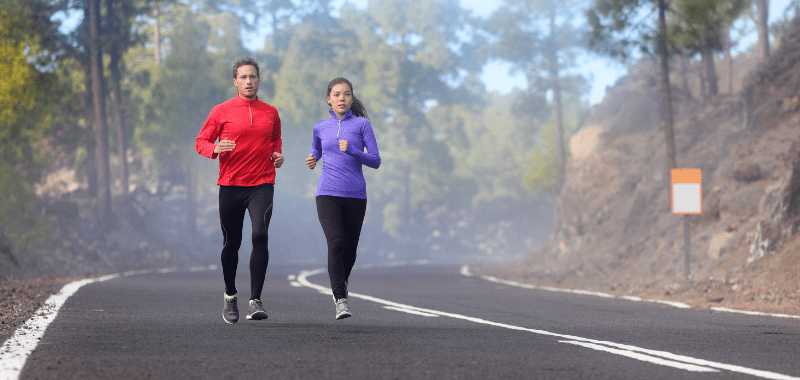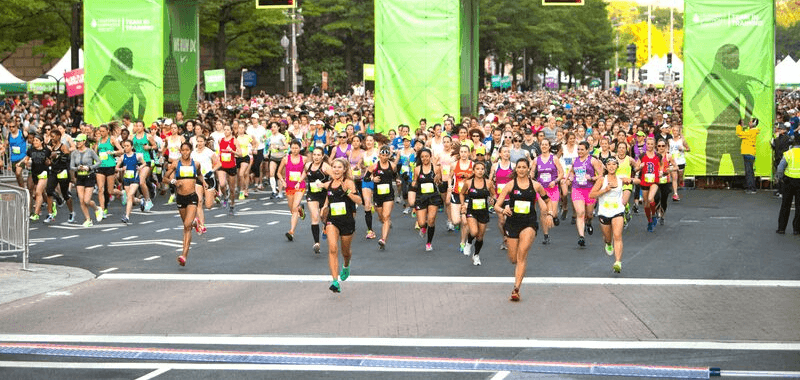Tabla de contenido
Hypoxia in running is a condition that occurs when there is a decrease in the amount of oxygen available to the muscles during exercise. This situation can result from training at high altitudes with lower atmospheric pressure. Therefore, there is less oxygen in the air, or from exercises that deliberately limit oxygen, such as training in hypoxic chambers or using hypoxia training masks.
Some runners and athletes choose to train in hypoxic conditions to gain performance benefits. This type of training should be done with caution and under supervision, as the body needs time to adapt to the lower oxygen availability. Additionally, the effects and safety of hypoxic training may vary among individuals.
It’s important to note that professionals should always supervise this type of training. It is not recommended to perform it without support.
Types of Hypoxia in Running
Hypobaric Hypoxia: Occurs when running at high altitudes (above 2,000 meters or 6,562 feet above sea level). At this altitude, the oxygen pressure is lower, making it more difficult for the body to absorb it into the blood. Runners may experience decreased performance, quicker fatigue, and longer recovery times.
Normobaric Hypoxia occurs when low oxygen availability is simulated without changing the altitude. This can be done with training masks or in hypoxic chambers. These tools reduce the amount of oxygen available while maintaining atmospheric sea-level pressure.
Effects of Hypoxia on Runner Training
Short-term:
- Hypoxia reduces the amount of oxygen available to the muscles, which can decrease performance.
- Increase in heart rate and ventilation (faster and deeper breathing).
- Faster onset of fatigue and exhaustion.
- Possible dizziness or difficulty concentrating, especially in unacclimated runners.
Long-term:
- Adaptation: The body can adapt to hypoxia by producing more red blood cells, which improves oxygen-carrying capacity. This is one of the principles behind altitude training, used by elite runners to enhance their performance.
- Performance improvement: After adaptation, when runners return to lower altitudes (with higher oxygen availability), they may experience a significant performance improvement.
- Risks: However, prolonged or improper exposure to hypoxic conditions can lead to health problems such as altitude sickness, pulmonary or cerebral edema, and other complications.
How to Improve Hypoxia Tolerance
Training to improve hypoxia tolerance can be done in various environments that simulate or induce conditions of low oxygen availability. Here are some of the most common places and methods:
1. Training at Altitudes Above 2,000 Meters
Training at natural locations such as mountains or elevated regions: Running at altitudes above 2,000 meters (6,562 feet) is one of the most effective ways to improve hypoxia tolerance. Some popular places include:
- Cochrane, Chile: A place in Patagonia with several high-altitude mountain routes.
- Flagstaff, Arizona, USA: Known for its routes and training at 2,100 meters (6,890 feet) above sea level.
- Chamonix, France: Located in the Alps, it is ideal for runners seeking high-altitude training.
- Mexico City, Mexico: The Mexican capital is over 2,200 meters (7,218 feet) above sea level, making it suitable for altitude training.
- Quito, Ecuador: The city is about 2,850 meters (9,350 feet) above sea level but also has routes at lower altitudes.
2. Training in Medium-Altitude Regions
Training in locations with altitudes between 1,500 and 2,000 meters (4,921 to 6,562 feet) can also improve hypoxia tolerance, though the effects will be more moderate. For example, Boulder, Colorado, USA, located at 1,600 meters (5,249 feet), is popular among elite runners.
Read more: Best places to train at altitude
Running and training at altitude
3. Hypoxic Chambers
- Specialized gyms: Some high-performance centers and gyms have hypoxic chambers that simulate sea-level altitude conditions. These spaces allow training at reduced oxygen pressure without traveling to mountainous areas.
- High-performance centers:
- High-Performance Center of Sierra Nevada, Spain: One of the most well-known in Europe, equipped with hypoxic chambers.
- Aspire Academy, Qatar: With state-of-the-art facilities that include hypoxic training.
4. Hypoxia Training Masks
- Personal use: Training masks can be used anywhere to simulate hypoxic conditions. However, the effectiveness of these masks is debated, and they do not entirely replace real altitude training.
- Indoor training: These masks can be used on a treadmill, indoors cycling, or during other aerobic exercises.
5. Intermittent Hypoxia Training
- Controlled breathing methods: Some training programs involve restricting breathing during specific intervals to simulate hypoxic conditions, which can be done anywhere.
- Specialized clinics: Some clinics offer intermittent hypoxia sessions, alternating periods of normal breathing with periods of breathing air with low oxygen content.
Benefits of Intermittent Hypoxia
- Improved Athletic Performance:
- Increased red blood cell production: Repeated exposure to hypoxia stimulates the production of erythropoietin (EPO). This hormone promotes the creation of red blood cells, thus improving the body’s ability to transport oxygen.
- Improved metabolic efficiency: The body learns to use oxygen more efficiently, enhancing endurance and recovery during exercise.
2. Rapid Altitude Adaptation: Athletes who train with intermittent hypoxia can adapt more quickly to high-altitude conditions, which is helpful for competitions in mountains or elevated terrains.
3. Health Benefits: Some studies suggest that intermittent hypoxia may positively affect cardiovascular and metabolic health, although these benefits depend on the intensity and duration of the training.
Considerations and Risks
- Individual adaptation: Not everyone responds the same way to hypoxia training. It is essential to adjust the intensity and duration of training to the athlete’s capacity and goals.
- Supervision: Since hypoxia can be stressful on the body, it is recommended to carry out this type of training under professional supervision to avoid adverse effects such as dizziness, extreme fatigue, or even more severe complications.
- Not suitable for everyone: People with underlying health conditions, such as heart or lung problems, should consult a doctor before attempting this type of training.
In summary, intermittent hypoxia is an advanced training strategy that, when done correctly, can improve the body’s ability to function in low-oxygen conditions, which can translate into better athletic performance and health benefits.
Elite Athletes Who Have Used Intermittent Hypoxia
Numerous elite athletes have incorporated intermittent hypoxia training as part of their preparation to improve performance in endurance competitions. Here are some notable examples:
Mo Farah
The British runner, multiple Olympic and world champion in long-distance events, has used hypoxic training, particularly in preparation for long-distance events. Farah has trained at altitude in places like Flagstaff, Arizona, and has used hypoxic chambers to enhance his aerobic capacity and oxygen efficiency.
Eliud Kipchoge
The Kenyan marathoner, considered one of the greatest of all time, has also taken advantage of the benefits of hypoxia. Although much of his training takes place at the natural altitude of his home country (in Iten, Kenya, about 2,400 meters or 7,874 feet above sea level), he is known to have used intermittent hypoxia methods to maximize his performance. This was key in achieving feats like breaking the 2-hour marathon barrier (in an unofficial event).
Kilian Jornet
The Spanish mountain runner and ski mountaineer, known for his incredible feats at high altitudes, such as his double ascent of Everest without supplemental oxygen, also uses hypoxia training. Kilian trains in the mountains, combining natural altitude with intermittent hypoxia to optimize his endurance and performance in extreme environments.
Chris Froome
The British cyclist and multiple Tour de France winner has incorporated intermittent hypoxia into his training, using chambers and devices that simulate low-oxygen conditions. This type of training is common among elite cyclists who seek to improve their performance in mountain stages and at high altitudes.
Allyson Felix
The American sprinter and multiple Olympic medalists have also included hypoxia training in her regimen. Although sprinters rely more on anaerobic power, intermittent hypoxia can improve oxygen efficiency, which is beneficial even in speed events.
These elite athletes use intermittent hypoxia training to enhance performance, especially when facing competitions at altitude or seeking to optimize their aerobic capacity and endurance.
Final Considerations
Training in hypoxic conditions should be done cautiously, as the body needs time to adapt. It is advisable to start with lighter training and gradually increase intensity. Additionally, it is vital to know the signs of altitude sickness and other adverse effects.
Each method and location can help improve hypoxia tolerance, translating into better performance in competitions at sea level or lower altitudes.
Looking for a plan that trains with you, not against you?
At running.COACH, we don’t just build a schedule. We create a smart, living plan that evolves with you. It understands your level, your race goals and your real life. Whether you sync your GPS watch or train straight from our iOS or Android app, your plan adjusts automatically as you improve.
From day one, you’ll feel the difference:
- A fully personalized, dynamic plan designed for you.
- Automatic sync and effortless workout tracking.
- Real-time updates when life happens, including missed sessions, new races or schedule changes.
- Simple, science-backed guidance to train smarter and recover faster.
🎁 Start today and enjoy your first 30 days free.
Because the best training plan isn’t one you follow. It’s one that follows you.app.











0 Comments